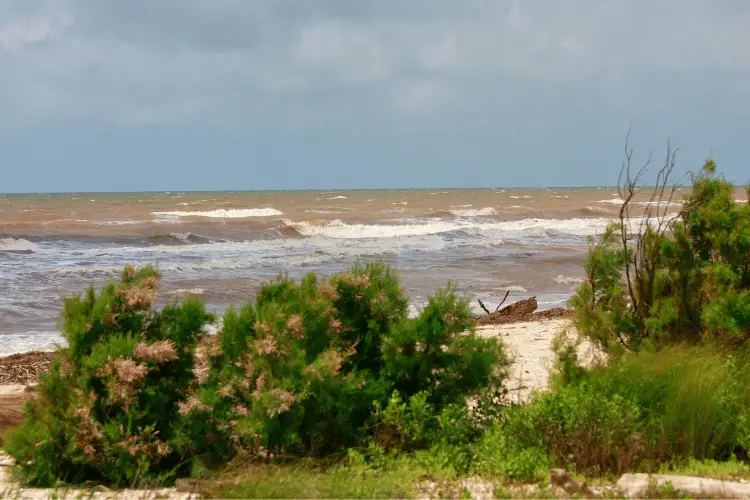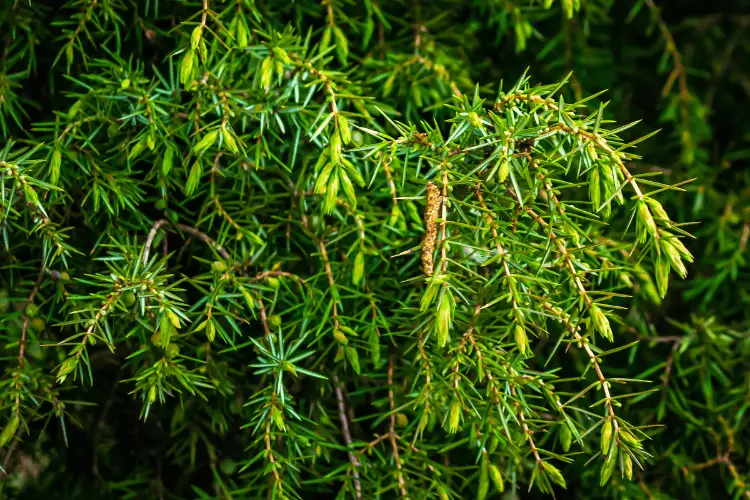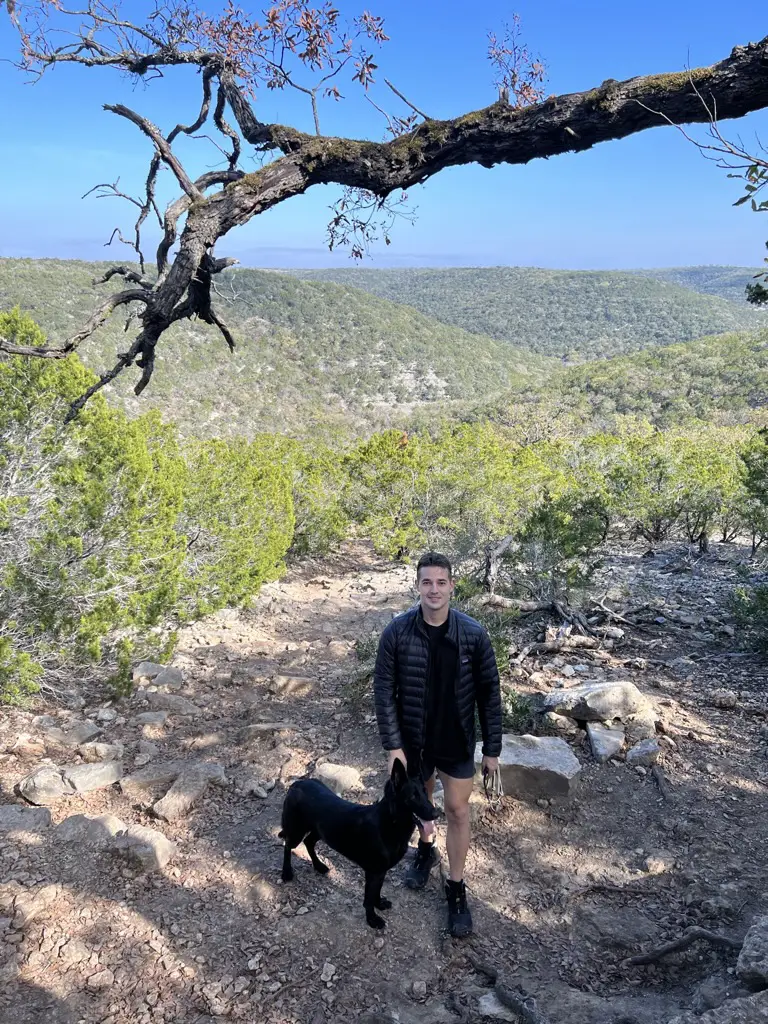We strive to provide you with authoritative, trustworthy, and expert advice. In doing so, the staff at texaswalkabout.com performs extensive research, editing, and fact checking to every post on this webiste. If you feel that this article can improve, please feel free to reach us at staff@texaswalkabout.com
Sparks fly at the mention of Texas cedar.
Things get particularly sticky when spring rolls around and the tops of Hill Country turn a mesmerizing blue. Residents find themselves reaching for the tissue box while allergists get busy.
The tree is such a hot topic that a Texan representative wanted to allow landowners to chop them down as they see fit.
Sniffles and watery eyes aside, the Texas cedar reflects the vibrant tapestry of the Lone Star State.
Here, we’ll explore its unique characteristics and ecological significance. We’ll also cover its cultural relevance and the polarizing debates surrounding its existence.
What Is Texas Cedar?
The Texas cedar is a dioecious shrub with distinct male and female plants. It is highly drought-tolerant and thrives in rocky outcrops.
The plant can grow into a medium-sized tree, reaching heights of up to 30 feet and a trunk diameter of 16 inches. The branches spread low to the ground, creating a dense canopy of dark-green foliage.
You can find the highest concentration of these evergreen trees along the western stretch of Interstate 35.
Contrary to its name, the Texas cedar isn’t a true cedar, belonging to the Pine family (Pinaceae).
Is Texas Cedar the Same as Juniper?
The short answer is yes.
Texas cedar encompasses several juniper species (Juniperus) within the Cypress family (Cupressaceae).
But how did it get its name?
European settlers who first came to the US and encountered Texas cedar named it cedar because of its similar aroma. But apart from the scent, the Texas cedar has no other resemblance to true cedars.
It wasn’t until 1932 that it officially became a juniper, but the name didn’t stick. Today, we still call many juniper trees cedar.
Where Did Texas Cedar Trees Come From?
It shouldn’t be surprising that Texas cedar is native to, well, Texas!
The origin of Texas cedar stretches back tens of thousands of years. It’s an ancient species as old as the Ice Age, as revealed by the discovery of fossilized juniper pollen in Texas.
Remnants of juniper charcoal found in burned rock middens or prehistoric oven pits confirm these findings. Eyewitness accounts from the 18th century also describe lush forests dominated by junipers.
The belief that the Texas cedar is invasive might have stemmed from a paperwork error in Austin. Allegedly, a clerk forgot to tick the box that said the tree is a native species!

What Kind of Cedar Grows in Central Texas?
The Ashe juniper (Juniperus ashei) is the predominant cedar species in Central Texas.
It goes by several aliases: Texas cedar, blueberry cedar, mountain cedar, post cedar, or rock cedar. John Buchholz, who first described the Ashe juniper, named it after the American botanist William Willard Ashe.
The tree is the only Juniperus species in the Texas Hill Country, sitting on the southeast area of the Edwards Plateau. It also ventures into the rangelands of South Texas Plains, Rolling Plains, and Cross Timbers.
Ashe Juniper forms sprawling low forests or impenetrable thickets called “cedar breaks.” These dense formations shape the gravelly lands of Central Texas.
Ashe Juniper: A Pervasive Species in Central Texas
Ashe juniper cannot re-sprout and burns quickly. Yet, that hasn’t stopped it from spreading like crazy.
Wildfire suppression efforts have led junipers to overrun savannas, choking out herbs and other trees. Overgrazing has destroyed much of the grasslands, contributing to the rampant growth of junipers.
The mountain cedar also flourishes on ranches where cattle shun its bitter seedlings.
On top of that, its aromatic resin can repel parasitic insects and makes its wood rot-resistant. It’s near-impossible to kill this plant!
Characteristics of Ashe Juniper
The Ashe juniper has a distinct appearance that’s hard to miss. Let’s look at those features:
- Shape: Ashe juniper is irregular, with a fluted and twisted trunk.
- Size: The tree rarely grows beyond 30 feet.
- Bark: It’s gray or reddish-brown, with white patches formed by the fungus Robergea albicedrae. On mature trees, the bark shreds into long, gnarled strips and develops shallow fissures.
- Foliage: The vibrant green leaves have overlapping scales and fringed edges. On younger plants, the leaves are narrower and pointed.
- Flowers: Ashe juniper has male and female cones on separate trees. Male conelets at the tip of branchlets are tiny and oblong, while female cones are oval and inconspicuous.
- Fruits: Female junipers bear fleshy blueberry-like cones containing 1–2 seeds. The fruit, which ripens in one season, is fragrant and sweet.
- Wood: The juniper wood is lightweight but hard, making it suitable for firewood and fence posts. Its grains are tight.
- Aroma: The tree has a distinct smell emanating from the resin glands in its leaves.
Uses of the Ashe Juniper
Here’s a roundup of the benefits of the mountain cedar:
1. Flood and Soil Erosion Control
Central Texas has earned the moniker “flash-flood alley” because of severe flooding, which ranks among the worst in the US.
The region benefits from vast stretches of land covered in Ashe juniper. With their dense canopy and thick leaf litter, the trees can intercept and reduce the volume and speed of rainfall.
Not only that, but they also prevent runoff and soil loss on steep slopes. When juniper needles fall to the ground, they absorb sediment-bearing water and create small berms that slow water flow.
2. Support for Native Ecosystem
Cedar breaks provide a natural habitat for a diverse array of native flora and fauna. They support various plant species, including rare orchids and other endophytes.
The low branches of juniper trees protect seedling and sapling hardwoods from browsing deer. During scorching summer months, their shade promotes the survival of plants and beneficial fungi.
What’s more, many mammals and birds feed on juniper berries and find shelter among the branches of these trees.
3. Heat Reduction
Ashe juniper woodlands lower air and soil temperature, counteracting the heat island effect. This phenomenon happens when cities radiate more heat than the surrounding countryside.
Juniper trees also capture and store copious amounts of carbon dioxide, aiding in reducing greenhouse gas emissions.
Drawbacks of Ashe Juniper
Now, let’s examine the adverse effects of this evergreen shrub:
1. Allergies
Each year, the Ashe juniper releases copious puffs of pollen during its flowering season.
A general malaise descends upon Texas cities, accompanied by sneezing fits and other allergic reactions.
2. Grazing Limitation
The extensive growth of Ashe juniper can limit the availability of forage for livestock, as the foliage is unpalatable to many grazing animals.
3. Water Competition
The Ashe juniper is a dominant species that can guzzle up water resources. Its dense foliage can prevent rainfall from infiltrating the soil.
The tree’s canopy cover acts as a barrier, causing rainwater to evaporate or drip slowly. Plus, the roots can extend deep into the ground and extract water reserves not easily accessible to other plants.
Interesting Facts About the Ashe Juniper
Check out some fun facts about the Ashe juniper:
- The tree provides prime habitat for endangered species, like the golden-cheeked warbler. These protected migratory birds build their nests out of juniper bark.
- Ashe juniper is a host plant to the Juniper Hairstreak butterfly.
- The tree has co-existed with woolly mammoths and saber-toothed tigers.
- Cedar choppers used to make their living from cedar charcoal and lumber.
- A few Ashe junipers along Austin and San Antonio roadways get a festive makeover every December. Some residents decorate roadside trees to honor loved ones lost in car accidents.
- The passing of House Bill 2239 would allow ranchers and property owners to cut down Ashe juniper trees.
Other Cedar Trees That Grow in Texas
Let’s explore other cedar trees and cultivars that found their roots in Texas soils:
1. Redberry Juniper (Juniperus pinchotii)
Also known as Pinchot juniper, it’s a small to medium-sized evergreen tree found in Central and West Texas. The gray bark reveals an orange-tan trunk when shredding.
It gets its name from the reddish-brown berries it produces.
2. Alligator Cedar (Juniperus deppeana)
The alligator or checkerbark juniper earns its name from its thick, cracked bark that looks like an alligator’s skin.
Although it’s one of the largest juniper trees, the alligator cedar is a sluggish grower. It has blue-green berry cones that can turn a reddish tan.
This species is native to the arid lands of West Texas.
3. Drooping Cedar (Juniperus flaccid)
Also known as weeping juniper, the drooping cedar has cascading branches and perfectly flat emerald sprays.
The bark is a delicate shade of cinnamon brown and peels off in slender strips.
This arboreal wonder can reach astounding heights of around 15–33 feet and spread another 33 feet horizontally.
4. Mountain Red Cedar (Juniperus scopulorum)
This juniper tree is a pyramidal conifer native to West Texas. It adorns the rugged vistas of the Rocky Mountains, thriving at elevations of up to 7,500 feet.
This resilient tree craves full sun and well-draining soil. It’s drought-tolerant, unfazed by salt sprays, dry soil, and erosion.
5. One-Seed Juniper (Juniperus monosperma)
With the grace of a sail, the one-seed juniper inches through life on the surface. Underneath, its tap root can plunge to extraordinary depths of up to 200 feet.
When moisture becomes scarce, the one-seed juniper can halt its growth. It only reawakens when sustenance returns.

6. Eastern Redcedar Juniper (Juniperus virginiana)
This evergreen tree can sport diverse shapes, like oval, pyramidal, or columnar. It can stretch about 40–50 feet high and 8–15 wide with tons of sunshine, making it ideal in windbreaks and screens.
The best part about the eastern redcedar is that it’s not overly invasive. There’s no need to worry about it taking over your backyard.
Does Texas Cedar Cause Allergies?
Yes, the Texas cedar causes allergies, famously known as cedar fever.
People usually get a break from allergies during winter when most plants become dormant. For many Texans, it’s only the beginning of their agony as it coincides with the juniper’s blooming season.
The pollen from the mountain cedar isn’t any worse for allergies than your average pollen. What makes it insidious is its sheer volume and density.
On a bad day, the mountain cedar’s pollen count can reach 10,000–12,000 grains per cubic meter. By comparison, an intense oak day can produce around 800.
Texans brace themselves when smoke-like haze billows off the top of male juniper trees. That’s the pollen grains from popped male cones en route to pollinate female juniper berries.
The juniper pollen can travel for miles on chilly, windy days. It’s not uncommon for people far from dense areas of mountain cedar to have bouts of this seasonal allergy.
Residents rely on local news stations for regular pollen count updates. This way, they can plan outdoor activities and load up on allergy remedies.
What Is Cedar Fever?
Cedar fever is an allergy caused by the pollen from the mountain cedar. It affects several states, including Arizona, Missouri, Oklahoma, and New Mexico.
Parts of Mexico and Japan are also no strangers to this seasonal pain.
But Central Texas has it the worst. Even residents without prior allergies find themselves battling symptoms.
The sneeze fest begins in mid-December and can persist until mid-February. It’s worse before and after a cold front when it gets dry and windy.
Pollen production of mountain cedar trees tapers off toward early March, just in time for other spring allergens like oak pollen.
Symptoms of Cedar Fever
Despite its name, cedar fever doesn’t typically cause a fever.
Apart from general misery, it mimics the flu-like symptoms of allergic rhinitis listed below:
- Sneezing
- Itchy and watery eyes
- Runny nose
- Nasal congestion
- Fatigue
People living with Asthma bear the brunt of cedar fever, which can trigger attacks and worsen symptoms.
Final Thoughts on Texas Cedar
The Texas cedar receives plenty of hate, particularly when temperatures dip. It’s infamous for being invasive and a water hog; landowners consider it nothing more than weed.
That said, Texas cedar is a keystone species in the Central Texas landscape. It enriches the limestone-rich soil and provides respite for migratory birds. Not to mention, it protects against air pollution, erosion, and flooding.
Whether you consider them friends or foes, Texas cedar is a significant part of the ecosystem.

Robert is a native Texan writer for TexasWalkabout, passionate about Texas culture and food, wearing cowboy boots daily. He interviews local pitmasters and chefs, tastes and reviews innovative dishes, and explores hidden gems and iconic landmarks. Graduating magna cum laude in Cyber Security from the University of Texas at San Antonio, Robert excels academically and professionally while also being knowledgeable in Texas history and culture. After living in Texas for over 28 years, he provides first-hand and trustworthy information for all your Texas needs!
